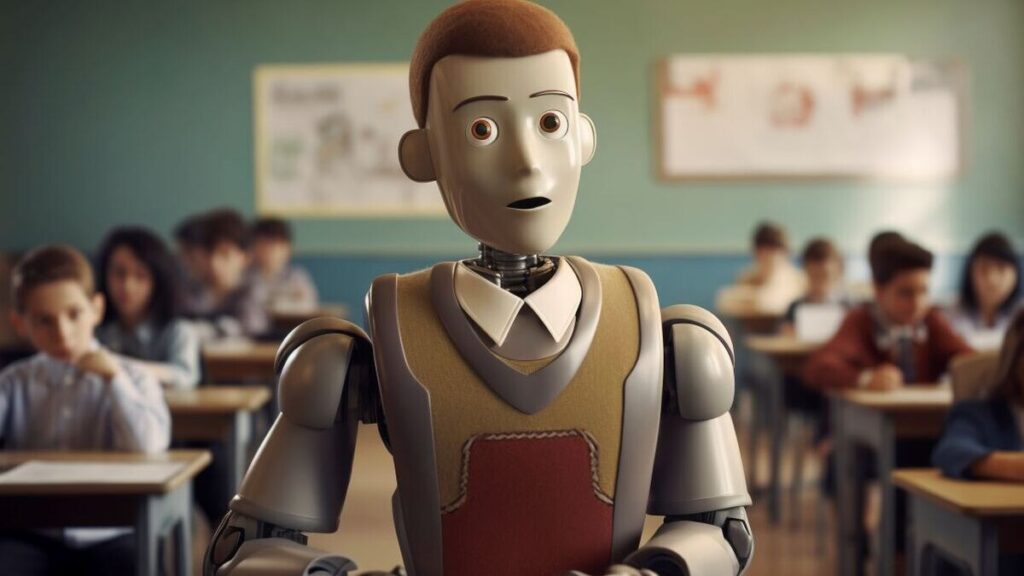Introduction
Imagine attending a graduate course, engaging in discussions, submitting assignments, and collaborating with classmates—only to discover later that one of your peers was not human but an AI-powered chatbot. Sounds like science fiction, right? Well, it happened. A chatbot successfully enrolled in a graduate-level course participated actively, and completed assignments without raising suspicion.
- Introduction
- The Rise of AI in Higher Education
- How a Chatbot Took a Graduate Course Without Detection
- The Power and Limitations of AI in Academia
- How AI is Already Assisting Students and Educators
- The Ethics of AI in Education
- What This Experiment Teaches Us About AI in Academia
- Step-by-Step Guide to Using AI in Academia Responsibly
- Challenges and the Future of AI in Academia
- Conclusion
This experiment showcases how AI in Academia is evolving rapidly, pushing the boundaries of technology and education. It raises critical questions:
- How well can AI mimic human intelligence?
- Should AI be used in higher education?
- What ethical concerns arise from AI’s involvement in coursework?
In this article, we’ll explore how a chatbot took a course undetected, the impact of AI in higher education, and what this means for the future of learning.
The Rise of AI in Higher Education
The use of AI in Academia has grown significantly in recent years. Universities worldwide are integrating AI to enhance learning experiences, automate administrative tasks, and provide personalized education.
How AI is Transforming Learning
From AI-powered tutoring systems to automated grading software, AI is reshaping education. These are a few of its most significant uses:
- AI-driven tutoring systems that provide instant academic support.
- Smart grading tools that evaluate assignments and offer feedback.
- AI-assisted research platforms that help students analyze complex data.
Student and Professor Perspectives
Educators and students have mixed reactions to AI’s role in academia. Some see AI as a revolutionary tool that enhances learning, while others worry about over-reliance on technology. Many fear that AI could eventually replace traditional learning methods, diminishing critical thinking and creativity.
How a Chatbot Took a Graduate Course Without Detection
So, how did an AI chatbot complete an entire graduate course without anyone realizing it wasn’t human?
The Chatbot’s Role in Assignments, Discussions, and Exams
- Active Participation in Discussions – The chatbot was designed with advanced natural language processing (NLP) capabilities, enabling it to generate well-structured responses during classroom discussions.
- Completing Assignments Using AI Tools—The AI utilized machine learning and content generation models to craft essays, solve problems, and submit coursework.
- Mimicking Human Interactions – The chatbot seamlessly blended in by maintaining a consistent tone, responding to emails, and even asking thought-provoking questions.
Why No One Noticed
The AI’s responses were so well-crafted that neither students nor professors suspected its true identity. AI-generated work was graded like any other student’s, proving how AI in Academia can be virtually indistinguishable from human participation.
The Power and Limitations of AI in Academia
While AI in Academia offers remarkable benefits, it also comes with limitations.
Advantages of AI-Driven Learning
- Instant Feedback – AI provides real-time assistance, helping students learn faster and more efficiently.
- Personalized Education – AI tailors learning experiences based on individual student needs.
- 24/7 Availability – Unlike human professors, AI-powered tutors are always accessible.
Ethical and Academic Integrity Concerns
- Lack of Emotional Intelligence – AI cannot truly comprehend human experiences.
- Risk of Over-Reliance – Excessive dependence on AI may weaken students’ problem-solving skills.
- Plagiarism and Authenticity Issues – Using AI for coursework raises concerns about academic honesty.
While AI can be a valuable educational tool, it cannot fully replace human learning experiences.
How AI is Already Assisting Students and Educators
AI is already transforming modern education, making learning more efficient and accessible. Its most significant contributions include:
- AI-Powered Tutoring Systems – Platforms like ChatGPT, Khan Academy’s AI tutor, and Socratic provide real-time academic assistance, answering student queries and explaining complex concepts instantly.
- Automated Grading Software: AI helps grade multiple-choice tests, short answers, and even some essays, saving educators time and ensuring consistent evaluation.
- Personalized Learning Platforms: AI analyzes student performance to recommend tailored courses and study materials, allowing individuals to excel in subjects that match their strengths.
However, concerns about academic integrity, plagiarism, and over-reliance on AI persist despite these advancements. Striking a balance between AI assistance and human learning is crucial to preserving educational authenticity.
The Ethics of AI in Education
One of the biggest ethical concerns surrounding AI in Academia is whether students should use it in their coursework. While some view AI as a helpful academic tool, like a spell-checker or calculator, others argue that using AI to generate entire assignments is academic dishonesty.
Plagiarism Concerns and Detection Methods
AI-generated content raises serious concerns about plagiarism, as students may submit work they did not create. To combat this, universities are implementing AI-detection tools, such as GPTZero, Turnitin, and Originality.ai, alongside plagiarism checkers to ensure fair academic practices.
Additionally, institutions are developing ethical AI usage policies, guiding students on responsible AI use while maintaining academic integrity. Striking a balance between AI assistance and originality is crucial for ethical learning.
What This Experiment Teaches Us About AI in Academia
The chatbot’s failure to complete a graduate course reveals AI’s potential and risks in academia. This experiment emphasizes the importance of AI literacy, as both students and educators must understand AI’s strengths, limitations, and ethical implications.
- The Need for AI Literacy – Without proper AI education, students may misuse AI, and professors may struggle to identify AI-generated work.
- Responsible AI Integration – Universities must establish clear, enforceable policies that define ethical AI use in coursework.
- Enhanced AI Detection Methods – As AI tools become more sophisticated, institutions must invest in advanced detection systems to maintain academic integrity.
By addressing these challenges, AI can become a valuable educational tool rather than a threat to traditional learning.
Step-by-Step Guide to Using AI in Academia Responsibly
To ensure AI is used ethically in education, students must follow key principles that promote responsible and fair use.
- Understand AI’s Role – AI should be an academic assistant, not a substitute for genuine learning. Use it to enhance comprehension, brainstorm ideas, or improve writing quality, but avoid relying on it to complete assignments.
- Follow Institutional Guidelines – Universities set AI usage policies to maintain academic integrity. Always review and adhere to these rules.
- Acknowledge AI Assistance – If AI contributes to an assignment, cite its role properly to maintain transparency.
- Use AI to Enhance, Not Cheat – Leverage AI for research, editing, and analysis, but ensure critical thinking and originality remain at the core of your work.
By embracing these principles, students can responsibly integrate AI while upholding academic honesty.
Challenges and the Future of AI in Academia
While AI is revolutionizing education, it also presents challenges:
- Bias in AI Models – AI can sometimes reflect human biases, leading to unfair grading or misinterpreting student input.
- Resistance from Traditional Educators – Some professors fear AI will diminish traditional teaching methods.
- Adapting University Policies – Schools must continuously update AI regulations to keep pace with technological advancements.
Despite these concerns, the future of AI in Academia looks promising. If used responsibly, AI will continue to support students, enhance research, and improve learning experiences.
Conclusion
The successful experiment of a chatbot completing a graduate course undetected highlights the rapid integration of AI in Academia and its profound implications for education. This unexpected revelation challenges educators, students, and institutions to reevaluate AI’s role in learning environments. While AI offers efficiency, automation, and personalized learning, it raises concerns about academic integrity, critical thinking, and ethical use.
As universities navigate this AI-driven era, they must focus on responsible AI adoption, ensuring it complements human intelligence rather than replacing it. Striking a balance between AI’s capabilities and human creativity will be crucial. The future of AI in Academia isn’t about eliminating students—it’s about enhancing education. The key question remains: Are we prepared for this transformation?


